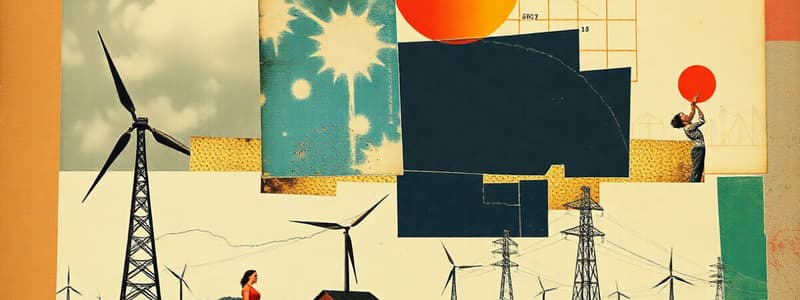Podcast
Questions and Answers
Which energy source is considered renewable?
Which energy source is considered renewable?
- Biomass energy (correct)
- Nuclear energy
- Geothermal energy
- Fossil fuels
What process leads to the formation of energy-rich fossil fuels?
What process leads to the formation of energy-rich fossil fuels?
- Photosynthesis and evaporation
- Wind and water cycles
- Burial and transformation through heat and pressure (correct)
- Solar energy absorption
Which country generates more than 99% of its electricity from renewable sources?
Which country generates more than 99% of its electricity from renewable sources?
- Canada
- United States
- Costa Rica (correct)
- Brazil
Which of the following is a non-renewable energy source?
Which of the following is a non-renewable energy source?
What natural phenomenon contributes to tidal energy?
What natural phenomenon contributes to tidal energy?
Which statement about energy distribution is true?
Which statement about energy distribution is true?
What role do plants, algae, and cyanobacteria play in energy production?
What role do plants, algae, and cyanobacteria play in energy production?
What is the main characteristic of non-renewable energy sources?
What is the main characteristic of non-renewable energy sources?
Which of these energy sources is NOT a product of the hydrologic cycle?
Which of these energy sources is NOT a product of the hydrologic cycle?
Flashcards are hidden until you start studying
Study Notes
Energy Sources
- Energy sources can be renewable or non-renewable.
- Renewable energy sources can be replenished within human lifespans.
- Non-renewable energy is finite and cannot be replenished within a human timescale.
- Renewable energy sources include solar, wind, and biomass energy.
- Non-renewable energy sources include nuclear energy and fossil fuels.
- Fossil fuels take millions of years to form from the remains of photosynthetic organisms.
- Geothermal energy is derived from the Earth's core.
- Tidal energy is generated by the gravitational pull of the moon and sun.
- Solar energy powers the water cycle and enables photosynthesis.
- The sun emits light, which creates wind.
- Biomass energy is derived from burning wood, biodiesel, or bioethanol.
- Nuclear energy is a non-renewable energy source.
Energy Distribution
- The United States generates less than 10% of its energy from renewable sources.
- Costa Rica generates more than 99% of its electricity from renewables.
Energy Impacts
- All energy sources have environmental and health costs.
- The distribution of energy is not equally distributed among all nations.
Studying That Suits You
Use AI to generate personalized quizzes and flashcards to suit your learning preferences.




